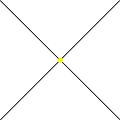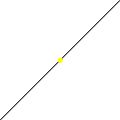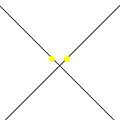Light tail test
The light tail test (also: tail test, Bagolini test, Bagolini strip glasses ) is an examination method with a very low degree of dissociation, which is used in strabismus medicine for the qualitative examination of simultaneous viewing and fusion and thus provides information about latent or manifest strabismus deviations . It can be used for examinations at a distance and near. The inventor of this procedure is the Italian ophthalmologist Bruno Bagolini, born in 1924 .
Investigation arrangement and evaluation
The instrument consists of a lens holder, similar to a spectacle frame without a bracket, but with a side handle ( lorgnon ). Very fine, oppositely arranged diagonally and closely spaced strips are incorporated into the flat glasses made of plastic . One makes use of a tail-like light scattering . If you hold this frame in front of your eyes and fix a small point-shaped light source, the normal sighted person will recognize two oblique light beams at right angles to each other, the intersection of which represents the light source. The right eye only sees the ray of the right glass, which goes from top left to bottom right, while the left eye perceives the ray of the left glass, which goes from top right to bottom left. Both visual impressions thus result in a tilted cross, the legs of which are aligned at 45 ° and 135 ° according to the TABO scheme . A similar effect of light scattering results, for example, when looking at the lighting of a street lamp in a car through a dirty, rain-soaked windshield.
Different perceptions are possible depending on the quality of the two-eye vision. If, for example, the visual impression of the right eye is suppressed due to a manifest squint, the test person will only be able to see the light beam from the left lens from top right to bottom left. If, on the other hand, there are double images ( diplopia ), two fixation lights are recognized, through each of which a diagonal light beam passes. Usually all forms of simultaneous vision, diplopia and fusion can be detected with this test.
- Schematic representation of some exemplary research results
A variant that was structurally and functionally further developed in the 1980s, in which the glasses can be turned towards each other, leads to a spatial effect of the perceived light strips for people with normal vision. This special arrangement is called Stereo-Bagolini - more rarely also Schuylini (after its (further) developer, the German ophthalmologist Klaus Schuy) - although the principle of this application also goes back to Bagolini.
The light wave test can also be used for a rough exposure examination of visual field deficits , including in glaucoma .
See also
literature
- Herbert Kaufmann (Ed.): Strabismus. With the collaboration of Wilfried de Decker et al. Enke, Stuttgart 1986, ISBN 3-432-95391-7 .
- Bruno Bagolini: Tecnica per L 'esame della visione binoculare senza introduzione di elementi dissocianti:' test del vetro striato '. In: Bollettino di Oculistica. Vol. 37, 1958, ISSN 0006-677X , pp. 195-209.
Individual evidence
- ^ AGM Jünemann, M. Wisse: The strip glasses according to Bagolini for the detection of visual field defects in glaucoma. 97th Annual Meeting of the German Ophthalmological Society (DOG), 1999.





